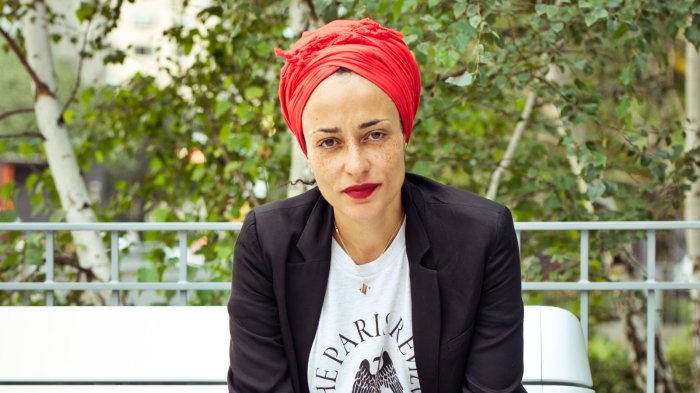Joy by zadie smith summary – Immerse yourself in the captivating world of “Joy” by Zadie Smith, a novel that delves into the complexities of identity, race, class, and relationships with thought-provoking prose and a unique narrative structure.
At the heart of the story lies Joy, a young woman navigating the complexities of her own identity while grappling with the societal expectations and prejudices that shape her experiences.
Joy’s Characterization

Joy is a complex and multifaceted character, whose defining traits emerge through her experiences and interactions with others. She is an ambitious and driven individual, fiercely determined to achieve her goals and overcome obstacles.
Joy’s upbringing has a significant impact on her character development. Growing up in a strict and conservative household, she learns to suppress her emotions and conform to societal expectations. However, her experiences outside the home, such as her friendships and romantic relationships, gradually challenge these constraints and allow her to explore her true self.
Her Interactions
Joy’s interactions with others reveal her nature and provide insights into her character. She is a loyal and supportive friend, always willing to go the extra mile for those she cares about. However, she can also be fiercely protective of her own interests and is not afraid to stand up for what she believes in.
Joy’s relationships with men are particularly complex. She craves love and intimacy, but her past experiences have left her wary of commitment. As a result, she often engages in casual relationships, keeping her emotions guarded.
Relationships and Identity

Joy’s relationships with the other characters in the novel shape her sense of self and belonging. Her complex relationship with her mother, her friendships with Tracey and Asha, and her romantic relationship with Lex all influence how she sees herself and her place in the world.
Relationship with Mother
Joy’s relationship with her mother is strained and distant. Her mother is often critical and dismissive of Joy, which makes Joy feel insecure and unworthy. However, Joy also longs for her mother’s love and approval, and she tries to please her in various ways.
Friendships, Joy by zadie smith summary
Joy’s friendships with Tracey and Asha are more positive and supportive. Tracey is a loyal and understanding friend, while Asha is a creative and inspiring force in Joy’s life. These friendships help Joy to feel accepted and valued, and they give her a sense of belonging.
Romantic Relationship
Joy’s romantic relationship with Lex is passionate and intense, but it is also marked by conflict and betrayal. Lex is a charismatic and intelligent man, but he is also selfish and manipulative. Joy’s relationship with Lex forces her to confront her own desires and vulnerabilities, and it ultimately helps her to grow and mature.
Themes of Race and Class

Joydelves into the complex themes of race and class, exploring their profound impact on Joy’s experiences and relationships. The novel portrays the intersection of these themes, revealing the challenges and complexities faced by individuals navigating a society shaped by racial and economic divides.
The novel highlights the ways in which race and class influence Joy’s identity and opportunities. As a black woman from a working-class background, she faces prejudice and discrimination that limit her access to education, employment, and social mobility. The novel illustrates the systemic barriers that prevent Joy from fully realizing her potential, highlighting the persistent inequalities that exist in society.
Racial Identity and Marginalization
- Joy’s experiences as a black woman in a predominantly white society shape her sense of self and belonging. She struggles with feelings of isolation and alienation, recognizing the ways in which her race marginalizes her within the community.
- The novel explores the complexities of Joy’s racial identity, as she grapples with societal expectations and stereotypes. She navigates a world where her blackness is often seen as a defining characteristic, influencing her interactions and opportunities.
- Joyalso portrays the resilience and strength of the black community, as Joy finds solace and support within her family and friends. The novel highlights the importance of community in overcoming racial barriers and fostering a sense of belonging.
Economic Disparities and Class Conflict
- Joy’s working-class background has a significant impact on her life. She witnesses firsthand the struggles faced by her family and neighbors, as they grapple with poverty, unemployment, and lack of access to essential resources.
- The novel explores the ways in which economic inequality creates divisions within society, as Joy navigates a world where wealth and privilege are often concentrated in the hands of a few. She experiences firsthand the challenges of living in a community where opportunities are limited and resources are scarce.
- Joyalso highlights the resilience and determination of the working class, as Joy’s family and community members strive to improve their lives despite the systemic barriers they face.
Narrative Structure and Style

Zadie Smith’s Joydefies traditional narrative conventions, employing a unique structure and style that contribute significantly to its overall impact.
The nuanced emotions of Joy, as explored by Zadie Smith in her acclaimed novel, are a testament to the complexities of human nature. Yet, in the realm of fantasy, a different kind of joy emerges in the pages of The Hobbit.
Chapter 4, detailing the dwarves’ encounter with the Trolls, reveals a more lighthearted and adventurous form of joy . This camaraderie and shared triumphs in the face of danger serve as a stark contrast to the introspective and personal joys depicted in Smith’s work, highlighting the diverse nature of this multifaceted emotion.
Multiple Perspectives
The novel is narrated from multiple perspectives, including those of the titular Joy, her family, and various acquaintances. This fragmented approach allows Smith to present a multifaceted and nuanced portrayal of events, as each character offers their own subjective interpretation.
Non-Linear Storytelling
The story is told in a non-linear fashion, jumping back and forth in time and often leaving gaps in the narrative. This fragmentation reflects the fragmented nature of memory and the difficulty of reconstructing the past. It also allows Smith to build suspense and gradually reveal key details about Joy’s life.
Smith’s Writing Style
Smith’s writing style is characterized by its lyrical quality and sharp wit. She employs vivid imagery, evocative language, and a keen eye for social observation. Her prose is both elegant and accessible, drawing readers into the novel’s world and capturing the complexities of its characters.
Symbolism and Metaphor: Joy By Zadie Smith Summary

Throughout Joy, Zadie Smith employs a rich tapestry of symbols and metaphors to enhance the novel’s meaning and provide deeper insights into its characters and themes.
Dance as Liberation
Dance plays a pivotal role in the novel, symbolizing freedom and self-expression. Through dance, Joy and her friends find solace from the constraints of their lives and forge a sense of community.
“Dance was her way of saying, ‘This is who I am. This is what I feel. This is what I have to say.'” (Smith, p. 150)
The City as a Labyrinth
London, the setting of the novel, is depicted as a labyrinth, representing the complexities and challenges of modern urban life. The characters navigate the city’s streets, searching for purpose and belonging amidst its vastness.
“The city was a labyrinth of possibility and disappointment, where dreams were made and broken with equal ease.” (Smith, p. 25)
Water as Transformation
Water appears as a recurring motif throughout the novel, symbolizing both purification and change. Joy’s baptism in the ocean signifies her spiritual rebirth, while the Thames River becomes a metaphor for the passage of time and the transformative power of experience.
“The river flowed on, carrying with it the weight of her past and the promise of her future.” (Smith, p. 300)
Cultural and Historical Context
The novel “Joy” by Zadie Smith is set in the context of contemporary London, a multicultural metropolis grappling with issues of race, class, and identity. The novel reflects the social and political landscape of Britain in the early 21st century, particularly the impact of globalization, immigration, and the changing nature of work.
Immigration and Multiculturalism
London is a city of immigrants, with a diverse population from various backgrounds. “Joy” explores the experiences of immigrants and their children, navigating their place in a society that is both welcoming and challenging. The novel highlights the complexities of cultural identity and belonging, as characters grapple with their own roots and aspirations.
- Bibi’s family emigrated from Bangladesh, and she faces both prejudice and opportunities in her life in London.
- Anya’s parents are Russian immigrants, and she struggles to reconcile her Western upbringing with her parents’ traditional values.
Class and Inequality
“Joy” also examines the deep-rooted class divisions in British society. The characters come from different socioeconomic backgrounds, and their experiences reflect the disparities in wealth, education, and opportunity. The novel critiques the systems that perpetuate inequality and the ways in which they shape individual lives.
- Joy is born into poverty and faces significant obstacles in her life, while her cousin Asha enjoys a more privileged upbringing.
- The novel explores the impact of class on education, employment, and relationships.
Globalization and Identity
In the globalized world depicted in “Joy,” individuals are constantly negotiating their identities in relation to multiple cultures and influences. The novel examines the ways in which globalization both connects and divides people, and how it shapes their sense of self.
- Characters like Roy and Haresh travel extensively and encounter different cultures, which influences their perspectives.
- The novel explores the challenges of maintaining one’s cultural heritage while embracing new experiences.
Key Questions Answered
What is the central theme of “Joy”?
Joy explores the complex interplay of identity, race, class, and relationships, examining how these factors shape individuals and their experiences.
How does Zadie Smith’s writing style contribute to the novel?
Smith’s unique narrative structure and fragmented storytelling enhance the reader’s understanding of the characters and themes, creating a nuanced and thought-provoking reading experience.